People and the Electric Grid
Air Date: Week of November 4, 2016
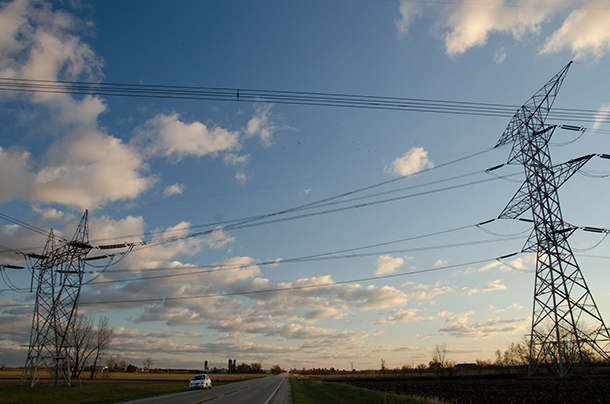
Electric Electric power transmission in the United States consists of three grid systems known as the Eastern, Western and Texas Interconnections. (Photo: Michael Kappel, Flickr CC BY-NC 2.0)
America’s aging electrical grid is caught between competing visions for how it should be reformed to cope with a changing climate, changing energy markets and new energy sources. McGill University anthropology professor Gretchen Bakke — author of “The Grid”— explains to host Steve Curwood how she thinks innovators, companies and ordinary citizens can work together to solve modern energy challenges.
Transcript
CURWOOD: It’s Living on Earth, I’m Steve Curwood.
With the flip of a switch, when evening comes light can flood our homes here in America. It seems so easy. But the electric grid is far from effortless for those on the frontlines of maintaining it. Behind the low of hum of kitchen appliances is a system that’s grown unwieldy, expensive to manage, and hard to integrate with new forms of energy generation and business models. Anthropologist Gretchen Bakke has written a book entitled "The Grid" that reveals how the electric grid’s intricate hardware has become entwined in a network of competing human interests. Gretchen Bakke joins us now on the line from McGill University in Montreal, where she teaches. Welcome to Living On Earth.
BAKKE: Thank you for having me.
CURWOOD: So I have to say this is the first book I've read about electricity by an anthropologist. What got you interested in the electric grid?
BAKKE: I think it is unusual for an anthropologist to study something as complicated and ubiquitous or every day as the electrical system, but one of the things that I discovered after doing research in Eastern Europe for several years, when I came back to visit my parents who live in rural Oregon, is that their grid was going down a lot. They were having a lot more blackouts than they’d ever had before, and that's where I really started to see that there's a way in which every day, regular people are interacting with this giant infrastructure in ways that they had been before, that there was a kind of letting go of this assumption that the state would do it, or that the utility would do it, and taking that on themselves.
CURWOOD: So, what's really interesting is that if someone is listening to us on the radio now that is plugged in, that radio is plugged into the grid, they're hearing us at the very same time that the signal is being sent from this recording. And the power that they have has all come at that same instance as the other people around the country who are in the same grid, and so you really can't store it as electricity.
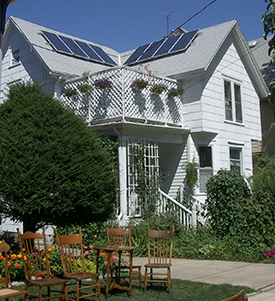
Although homeowners are increasingly turning to small solar systems for their energy, the variable nature of solar and other kinds of renewable energy creates complications for the grid. (Photo: Jascha Jabes Flickr CC BY-NC-ND 2.0)
BAKKE: You can't store it at a scale that's significant enough to make a difference to the grid because the grid is very, very big. We know we can store it in small amounts. We have batteries in our telephones, for example, and our computers, but it's difficult to engineer perfectly that kind of storage device for a grid that is half-national in size. Because we have, in the US we have three of them. We have one for the whole West. We have one for the whole East, and Texas has its own. So we have these three huge grids with thousands of power plants that are working in sync on each side.
CURWOOD: What do you see as the grid's biggest weaknesses?
BAKKE: There are several. The classic one is simply that is old. It was built and designed for the 20th century, and a lot of the power plants that we’re still using are from the 1950s, 1960s, 1970s, and many of those are being retired now. So, nuclear power plants are being retired. Coal-burning power plants are being retired, and they're being replaced with natural gas, wind power, and solar. So 97-percent of the new electrical generation that came online in 2015 was one of those three, and wind actually outpaced natural gas.
CURWOOD: And why does that make a problem for the grid?
BAKKE: Because it's an infrastructure that it's not quite like the other infrastructures we're used to, and the grid we made throughout the 20th century was designed to allow people to use as much electricity as they wanted, whenever they wanted, for a very fair price, but the way that that functioned with the grid is that we controlled how much...All of the control was on the side of how much power we made. So people could use much as they wanted, but on the production side that would be matched, by just turning a power plant up, for example.
And what's happened with renewables is that now, if you have wind power, the wind blows. And how fast the wind blows or when the wind blows determines how much electricity is going into the grid. So, you have this variability on the production side, and you also have a variability, still, on the use side, which is us. And so, suddenly, instead of trying to balance one thing you're balancing two things which don't necessarily jive with one another, and that's just far more complicated.
CURWOOD: And I have to ask you, why our power outages becoming more and more common? You begin your book with a series of outages. You say that, you know, the average American will, what? Put up with as much as six hours a year; whereas, somebody in Japan might only have 15 minutes a year?
BAKKE: Yeah, exactly. And you know it. These outages happen all the time, and some of them are quite short, but they’re a very common part of American life in a way that they aren't in the rest of industrialized world.
Part of it has to with the fact that now you can make a profit on electricity, so electricity gets bought cheaply and sold dearly and shipped across the system in ways that the lines simply weren't made for. And this is this misunderstanding of electricity being like a car, right? Like that it doesn't matter where you get it, and where you use it. You just sort of move it on the infrastructure, and it's all the same. But power lines become less efficient, the further you send the electricity, so you start to have these sort of weird harmonic resonances and dissipation of electricity off of power lines simply because the structure of how profit is now made, after the age of the internet, is different with the power system.
CURWOOD: So, in the old system there was profit, but it was set at a particular level, and there was no way for speculators and folks on Wall Street, really, to make a big buck. Today now we've open the door, huh?
BAKKE: Yeah, absolutely we treat electricity like any other commodity.
CURWOOD: But it's not, is it? I mean, like you write your book, you can't really store large quantities of it. Here you use it or you lose it.
BAKKE: Yes, you use it or it destroys the system. (LAUGHS.) That's the thing. It's like, you can't...you don't make it, you have to not make it because having too much on the wires is as bad for the system as having too little on the wires.
CURWOOD: So you're saying we have this disconnect between how folks looking to make money on speculation and margins are pushing a system that wasn't at all really designed to do that.
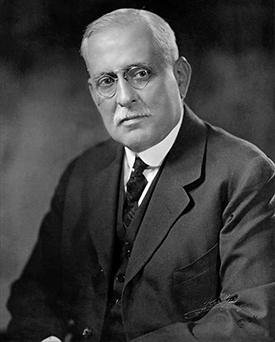
Samuel Insull played a key role in the creation of America’s integrated electric infrastructure during the Industrial Age. (Photo: William L. Koehne Studio, Chicago (Print magazine) [Public domain], via Wikimedia Commons)
BAKKE: Exactly, exactly. And one of the things I discovered when I went into this book is, I thought I was writing a book about technology and people and sort of the social culture of origins of a technological system, and what a lot of the book is, is in fact a business history.
CURWOOD: So, tell me the story now.
BAKKE: Yeah, I think what is one of the most fascinating things is that we think of a mass market as being something that America always had, that there was this idea that you could sell things to everybody at a low price and make money off of them, and that that was not the story. In fact, as electricity became something that was changing from a thing for the rich into a thing for everybody, the sale of things like an iron you can plug-in, it came with electricity. So electricity was one of the first place that there was this idea that you could make money selling a little bit of something to a lot of people. And the way that happened was that originally it was really only an elite…It was only for elites and for factories, and that part of that is because grids were quite small in the beginning. We used what is called direct current, and direct current doesn't go very far, and it has to be produced at the voltage which is used, which sounds complicated but it just means that if you are a streetcar company you are not going to produce the same voltage at the power plant that somebody who just needs a lighting system is going to have.
And then things began to change, and we adopted alternating current, and the grids got bigger. And, as they got bigger, the economics of inclusion started to shift, so that any place that was dense - so urban centers - could start to bring people into a larger, public grid. And then after the Great Depression Roosevelt came in and said, “Look, everybody needs electricity. This is something that everybody needs like potable water.” It becomes part of a program of national uplift, and he gets the federal government to fund the extension of wires out to rural areas, poor areas that utilities never would've reached otherwise because they simply couldn't make any money off of them.
CURWOOD: Your write about government's involvement with electricity, bringing it to every home but not just in the sense of electrifying, but in the business model.
BAKKE: Yeah, absolutely. So, the problem with electricity is that the greatest cost with the old model, the greatest cost for the utilities was actually the interest on the loans for the power plants. And because of this they needed really low-interest rate, guaranteed loans, and so they began to talk.
One particular innovator, Samuel Insull in Chicago, began to talk to government about regulating the industry. He wanted to be regulated. So we can think of industries not wanting to be regulated or fighting regulation, but, in fact, Insull, he wanted to be regulated, not by politicians because politicians were...They were an iffy bet in the 1910s and 20s, so Samuel Insull and progressive politics kind of came together to create a bureaucracy of regulation that allowed the utilities to function as what were called natural monopolies, and this is why still in most places in the US there is no competition within the domain of a utility. You don't have a choice if you pay your bill to Pepco or someone else. You have to pay the bill to whoever it is rules your area. But, unlike a regular monopoly, they were not allowed to set the prices however they wanted, and that's because they were regulated by government. So government, actually, legislatures in some cases or regulatory bodies, still sets the price of electricity within any particular region.
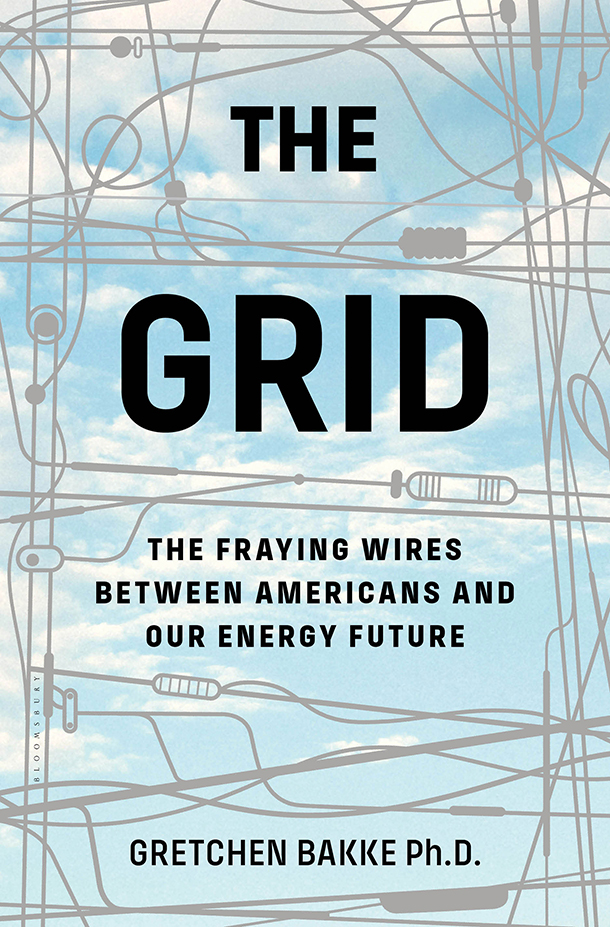
The Grid evaluates the future of America’s electrical grid from an anthropological perspective. (Photo: Sara Mercurio)
CURWOOD: Now, in your book you write about a turning point, perhaps, a vote in Congress that passes with just one vote in the House that declares that utilities must buy energy from small energy providers. This is PURPA. This is the Public Utilities Regulatory Policies Act. So, tell me how this law passed, and the Jimmy Carter era began to break down the monopolistic energy grid that we inherited from the industrial age.
BAKKE: Well, Jimmy Carter was elected on a platform of energy reform, and he did many many things with this act, fuel efficiency in cars, ecetera, etcetera, etcetera. And one teeny, tiny piece of this was to require utilities essentially not to be monopsonies, which is a funny word that we don't use very much. But he said it's fine if they are still monopolies. They can have their...They can control their land. But what this act did, is it said no utilities for these tiny, tiny amounts of electricity. You have to buy it, and you have to buy it at a reasonable rate. You have to buy it at the rate it would cost you to make it, and it opened the door to, just kind of on a whim, it feels like, it opened the door to what was called “unconventional generation.”
And that meant tiny little hydroelectric dams were going, went all over California. Wind turbines which were a very, very unproven technology at that time, like, many of them didn't work at all or didn't work for very long, but, nevertheless, the people building wind turbines or putting together solar powered systems, they had the right to sell their electricity to the utilities, and utilities had to buy it and had to move it to market.
And people get very excited about it. It was small in the beginning, but it grew and grew and grew and grew and grew. Even Wall Street started to invest in these systems. And in the 1980s, which we tend to think of the Reagan years as this sort moment of decadence and excess and nothing really interesting going on on the greener side of things, this was actually when PURPA came to life. So it wasn't percolating up into the media or into popular consciousness, but wind farms were going in. Strange little things were being built. So it was the 80s sort of under the wire - Excuse the pun - where the time at which the revolution that we now are in the midst of, really got feet.
CURWOOD: So, how resilient is America's grid to natural disasters like, well, that huge storm out on the west coast known as the Great Gale or Superstorm Sandy?
BAKKE: It's not resilient to natural disasters. We can't really create an infrastructure that will never go down, but what we can create an infrastructure that we can fix more quickly. And I think that's what a lot of people are after is, yes, it goes down, but it only goes down for a couple of hours. It doesn't go down for a week.
And this is where the micro grids start to come in. So, a micro grid is...It's a system that has more than one form of generation, and it also has to have more than one meter or more than one customer. So it's essentially just like the big grid but on a much, much smaller scale. If New Jersey Transit System, for example, which runs train lines all throughout New Jersey but in and out of Manhattan as well, if they can make that micro grid work, not only do the trains work but every single train station becomes the place, becomes a warming center, becomes a place where people can charge the phones. To have these sort of pockets of warmth and light and power is a first step, and those systems are not isolated from the grid all the time. They can just work when the rest of the grade goes down.
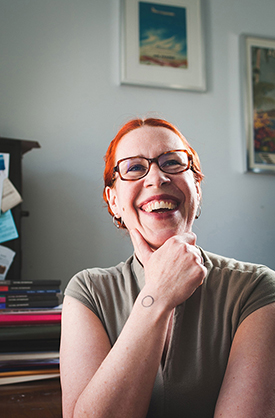
Gretchen Bakke is an Anthropology professor at McGill University. (Photo: Alex Tran)
CURWOOD: So, what do you make of the research done by some folks at NOAA, saying that in 15 years we could have 80 percent renewables, if the grid were all connected with high voltage DC, so we can have a true national grid?
BAKKE: Right. So this is...That's a wonderful plan. This is sort of where the anthropology piece of it comes in because it's great. They're right, hands down, but how do you build those wires? People don't want the wires in their backyard anymore. Nobody wants any more wires to go in. So what do people like? People like solar. People like small solar systems. OK, then you get somebody like Elon Musk who comes along and says, “Well, if people like to make small amounts of electricity, let's let them store small amounts of electricity.”
So, then there is this other competing dream, and I think that's one of the things that really differentiates the way that the US is dealing with the transition to renewables versus Europe, because in Europe very often there will be a plan from on high that says, “This is how we're going to manage it.” It doesn't mean it works perfectly, but there's a plan. And in the US you can have a plan, but how do you instrumentalize that plan? And I think that's the big question with the NOAA proposal. It doesn't mean it is a bad plan at all. You still have to make it happen. You have to get it funded. People have to let you on to their back-40, so how do you overcome that?
My suggestion is that you think about, or pay attention to, sort of the patterns of what people do actually like to do, what they do put their money toward, what they are attentive toward, and figure out how to build up from that. Also, from the people who are trying to make money off of it. So there's sort of the dreamers and there's the capitalists, and there's the planners, and there's the regulatory bodies. And the question is, how do you string these people, or tie these people, together? And of course, that's always the American question, right? The grid is no different in this regard. It's always the American question. But I think that with our eye on the prize, it can actually be done.
CURWOOD: Gretchen Bakke's book is called "The Grid: The Fraying Wires Between Americans and Our Energy Future". Thank you so much for taking the time with us.
BAKKE: Thank you.
Links
The Grid: The Fraying Wires Between Americans and Our Energy Future
Living on Earth wants to hear from you!
Living on Earth
62 Calef Highway, Suite 212
Lee, NH 03861
Telephone: 617-287-4121
E-mail: comments@loe.org
Newsletter [Click here]
Donate to Living on Earth!
Living on Earth is an independent media program and relies entirely on contributions from listeners and institutions supporting public service. Please donate now to preserve an independent environmental voice.
NewsletterLiving on Earth offers a weekly delivery of the show's rundown to your mailbox. Sign up for our newsletter today!
 Sailors For The Sea: Be the change you want to sea.
Sailors For The Sea: Be the change you want to sea.
 The Grantham Foundation for the Protection of the Environment: Committed to protecting and improving the health of the global environment.
The Grantham Foundation for the Protection of the Environment: Committed to protecting and improving the health of the global environment.
 Contribute to Living on Earth and receive, as our gift to you, an archival print of one of Mark Seth Lender's extraordinary wildlife photographs. Follow the link to see Mark's current collection of photographs.
Contribute to Living on Earth and receive, as our gift to you, an archival print of one of Mark Seth Lender's extraordinary wildlife photographs. Follow the link to see Mark's current collection of photographs.
 Buy a signed copy of Mark Seth Lender's book Smeagull the Seagull & support Living on Earth
Buy a signed copy of Mark Seth Lender's book Smeagull the Seagull & support Living on Earth

